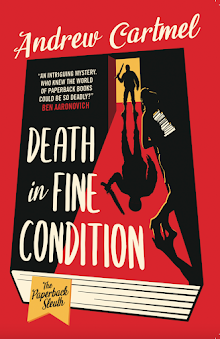 In much the same way that John D. MacDonald is the crime writer I most admire, Fritz Leiber is my favourite writer of science fiction, fantasy and horror — Leiber excels in all three fields.
In much the same way that John D. MacDonald is the crime writer I most admire, Fritz Leiber is my favourite writer of science fiction, fantasy and horror — Leiber excels in all three fields. The Wanderer is the first of these — science fiction — and indeed won the Hugo award for best SF novel of 1965. It's one of the genre's all time classics.
It tells the tale of what happens when a new planet suddenly appears above the Earth — popping out of hyperspace — just beyond the orbit of the moon.
 What largely happens, of course, is earthquakes and flooding caused by monstrously magnified tides as a result of the planet's gravitational impact on us.
What largely happens, of course, is earthquakes and flooding caused by monstrously magnified tides as a result of the planet's gravitational impact on us. Leiber's account of this is characteristically knowledgeable and well-informed, as he tells us for instance that the safest places at sea are the “tidal nodes near Norway and the Windward Isles and at Tahiti.”
 But science fiction writers who know their science are pretty commonplace. What sets Leiber apart is the brilliance of his imagination and, above all, the superb quality of his prose. He really is the ultimate SF and fantasy writer, combining these traits to great effect.
But science fiction writers who know their science are pretty commonplace. What sets Leiber apart is the brilliance of his imagination and, above all, the superb quality of his prose. He really is the ultimate SF and fantasy writer, combining these traits to great effect.He talks about how the new planet — soon dubbed the Wanderer — has “poisoned the radio sky" with static. And when it becomes clear that this world is inhabited, and indeed piloted, by aliens he talks about the shocking impact on the human psyche.
 It is an end to our secure isolation in the galaxy —“how safe the Earth had swung in all its loneliness for millions of years, like a house to which no stranger ever comes.”
It is an end to our secure isolation in the galaxy —“how safe the Earth had swung in all its loneliness for millions of years, like a house to which no stranger ever comes.” Initially the book functions like a disaster novel (indeed it virtually invents that genre), moving swiftly between groups of characters as they deal with the catastrophes conjured by the new planet's presence.
But soon Leiber moves on to the more fascinating possibilities of human interaction with the inhabitants of the Wanderer.
 Leiber shows great psychological acuity, as when his heroine Margo Gelhorn acquires
one of the aliens' weapons, a fascinating device she calls a "momentum
pistol." (It is literally dropped from a flying saucer.)
Leiber shows great psychological acuity, as when his heroine Margo Gelhorn acquires
one of the aliens' weapons, a fascinating device she calls a "momentum
pistol." (It is literally dropped from a flying saucer.) At first Margo revels in the confidence it gives her, then she discovers she doesn't need it any more, having developed her own inner resources: “she herself was now the big gun she could rely on and experiment with.”
The book just keeps on getting better, as we discover who the Wanderer's inhabitants are, and why they're here.
 The beautiful cat-like Tigerishka (a name she adopts, combining her fondness for Earth's big cats... and ballet) explains, "your juvenile delinquents — we're like those. Running, running, running. Every step, pounding the hollow planetary pavement, under the cold streetlight of the stars." And the Wanderer is their "getaway car."
The beautiful cat-like Tigerishka (a name she adopts, combining her fondness for Earth's big cats... and ballet) explains, "your juvenile delinquents — we're like those. Running, running, running. Every step, pounding the hollow planetary pavement, under the cold streetlight of the stars." And the Wanderer is their "getaway car."And then we find out what it is that the Wanderer's inhabitants are running from...
 I realise the feline aspect of some of the cover art depicted here might suggest to you that I love this book because I'm a sucker for cats. Trust me, there's a lot more to it than that. The Wanderer is a masterpiece and I commend it to you most heartily.
I realise the feline aspect of some of the cover art depicted here might suggest to you that I love this book because I'm a sucker for cats. Trust me, there's a lot more to it than that. The Wanderer is a masterpiece and I commend it to you most heartily.(Image credits: The Philip Castle airbrushed "good cat art" cover is my own scan of my own copy. The handsome Gollancz yellow typographic copy is also my own — and I can't find another image of this anywhere on the internet. The original Ballantine printing of people fleeing is from Lankhmar, a useful and interesting site dedicated to Leiber. The two French covers are from a Pinterest gallery. The other covers are from Good Reads.)




This novel and writer are two favorites. I've read The Wanderer three times and always find a new way to enjoy it. I suspect quite a few filmmakers read it, also. Good choice, Andrew.
ReplyDeleteHi Al! Great to hear from you. I was shocked to read that The Wanderer is largely forgotten among the SF community. I intend to put that right. And you can expect a lot more Leiber to come. I've rediscovered how tremendous he is and there's lots to write about! PS: Your observation about film makers is fascinating. Can you recall any specific examples we can discuss?
DeleteIs this a series?
ReplyDelete